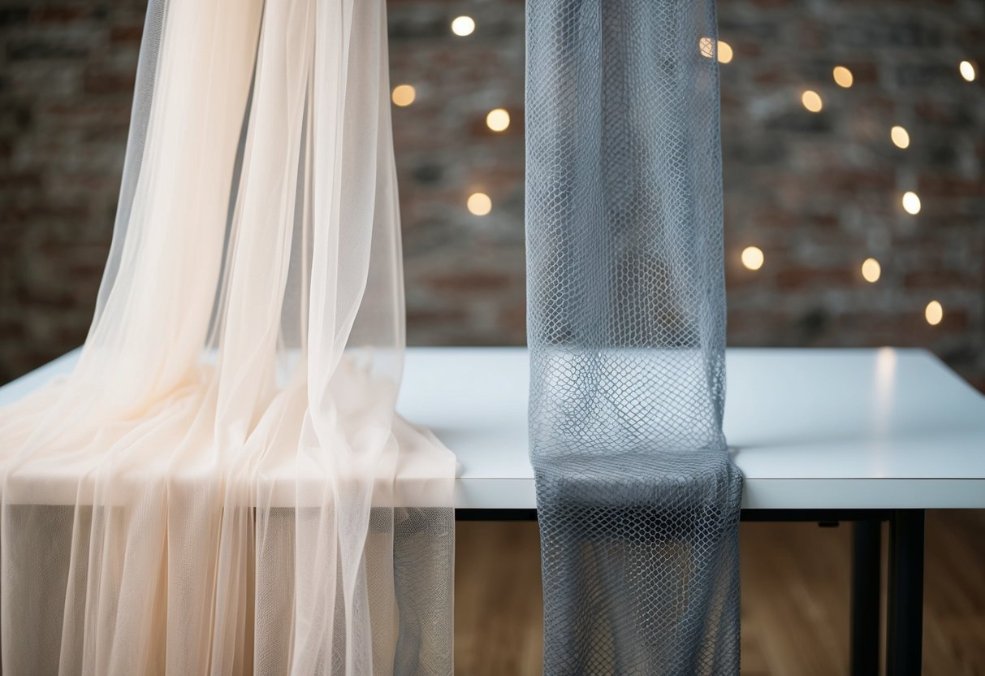Unravel the distinct characteristics of these sheer favorites to make informed decisions for your next fashion or decor project
Tulle and mesh fabrics appear similar at first glance, with their distinctive open weave patterns. Mesh features a loose, knotted structure ideal for sportswear and practical applications, whilst tulle is a finer, more delicate netting fabric perfect for formal wear and decorative uses.
Tulle’s unique characteristics stem from its historical origins in the 1800s when John Heathcoat developed a machine to replicate handmade lace. The resulting fabric became a staple in wedding gowns, ballet costumes, and formal attire.
Modern mesh fabrics offer superior breathability and durability compared to tulle, making them a popular choice for athletic wear and contemporary fashion. The fabric’s versatility shows in its wide range of applications, from sports jerseys to evening wear overlays.
On This Page
Key Takeaways
- Tulle features finer fibres and smaller holes than mesh, creating a more delicate appearance
- Mesh provides better durability and breathability for practical garments and sportswear
- Each fabric serves distinct purposes, with tulle excelling in decorative uses and mesh in functional applications
Defining Tulle and Mesh
Mesh fabric consists of connected strands that form a net-like structure. These strands can be made from various materials, including synthetic fibres or metal, creating a strong and flexible material.
Tulle is a delicate, sheer fabric with a distinctive hexagonal pattern. Its fine, lightweight construction gives it an ethereal quality that makes it popular in formal wear and decorative applications.
Both fabrics feature an open-weave design, but their construction methods differ significantly. Mesh uses a more structured weaving pattern, whilst tulle relies on a specific knotting technique.
Mesh offers superior breathability and durability, making it ideal for sportswear and functional garments. Its sturdy construction allows for more practical applications.
Key Characteristics:
- Mesh: durable, structured, versatile
- Tulle: lightweight, airy, decorative
The airy texture of both fabrics makes them popular choices in fashion and textiles. Mesh tends to have a more modern, sporty appearance, whilst tulle creates a romantic, soft aesthetic.
Historical Context
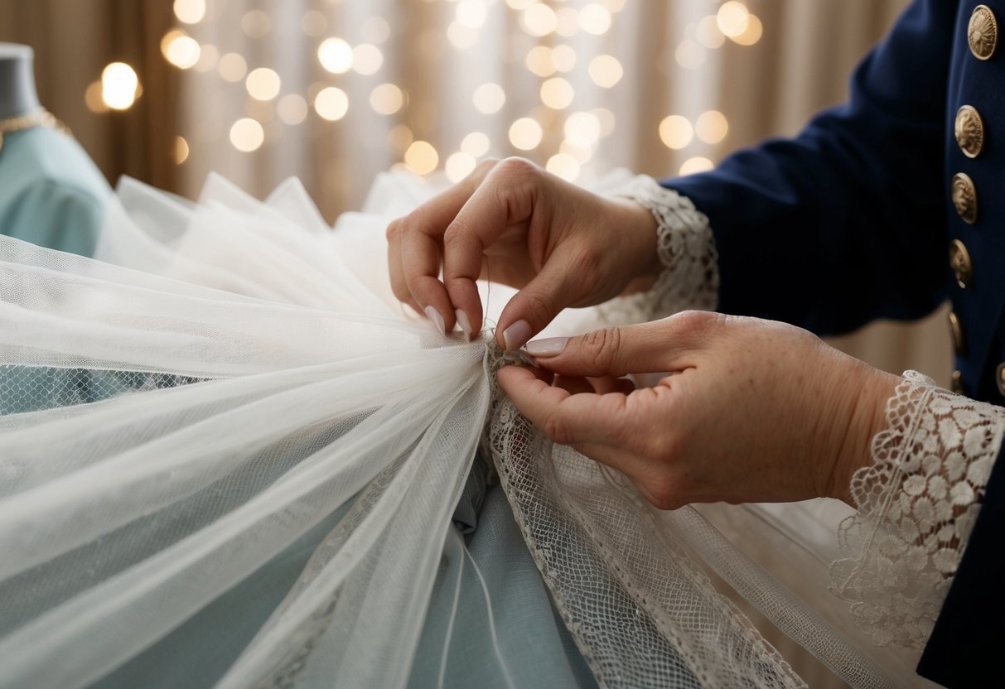
Tulle fabric got its name from the French city of Tulle, where it was first produced by machine in 1817. The city played a crucial role in developing this delicate netting material.
The first mechanical production of tulle actually began in Nottingham, England in 1768. This breakthrough came after the invention of the bobbinet machine in 1806, which revolutionised the manufacturing process.
Mesh fabric emerged as a versatile material made from connected strands. These strands could be crafted from various materials, including fibres and metals.
Traditional tulle started as a simple netting material in the early 18th century. It quickly found its place in ballet costumes and bridal veils.
During the 1800s, tulle became essential in fashion. Dressmakers used it as a base material for skirts and petticoats, which were worn beneath elaborate gowns.
The fabric evolved significantly through the years. While originally made from silk, manufacturers began using cotton and rayon. By the 1950s, nylon became the most common material for tulle production.
Types of Tulle
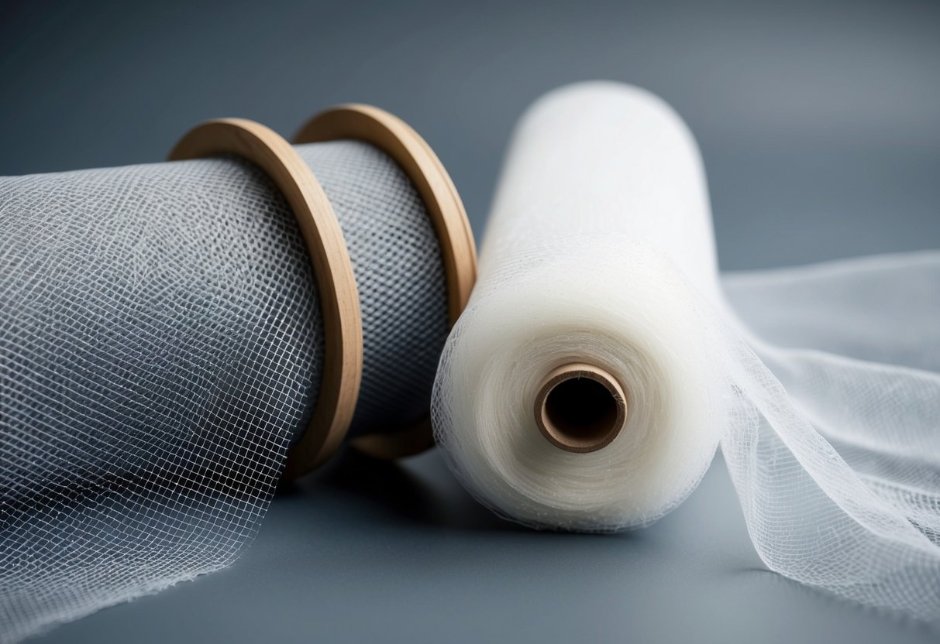
Different types of tulle fabric are made from distinct materials that give them unique properties and uses. Each type offers specific benefits for different sewing and crafting projects.
Nylon Tulle
Nylon tulle is one of the most common and versatile options. Its durability and strength make it perfect for dancing costumes and formal wear.
The material resists tearing and maintains its shape well after washing. It comes in both soft and stiff varieties.
This type offers excellent colour retention and is available in countless shades. The price point makes it accessible for most projects.
Polyester Tulle
Polyester tulle provides excellent durability at a lower cost than other varieties. It holds its shape remarkably well, even after multiple washes.
The fabric has a crisp texture that works brilliantly for underskirts and petticoats. It’s resistant to stretching and shrinking.
Many crafters choose polyester tulle for large-scale projects due to its affordability and consistency.
Silk Tulle
Silk tulle represents the highest quality option. Its incredibly fine mesh creates an almost invisible appearance that’s perfect for bridal veils.
The natural fibres offer unmatched softness and drape. Its delicate nature requires careful handling and gentle washing.
The cost is higher than synthetic options, but the luxury feel makes it worth the investment for special occasions.
Stretch Tulle
Stretch tulle contains elastic threads that allow it to stretch in all directions. This flexibility makes it ideal for fitted bodices and form-fitting garments.
The material offers excellent recovery, returning to its original shape after stretching. It provides more comfort than traditional rigid tulle.
This variety works well for dance costumes where movement is essential.
Illusion Tulle
Illusion tulle features an ultra-fine mesh that creates a nearly invisible appearance on skin. Its lightweight nature makes it popular for bridal veils and delicate overlays.
The material has a soft drape and smooth texture. It blends seamlessly with other fabrics.
This type often appears in high-end fashion and bridal wear due to its refined appearance.
Characteristics and Properties
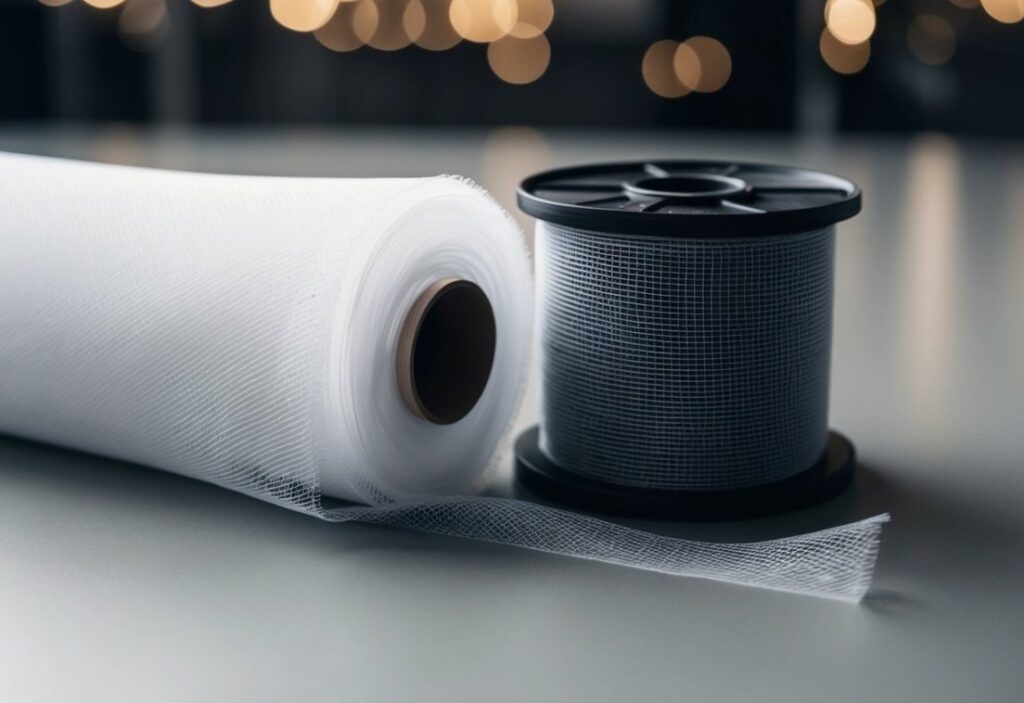
Mesh and tulle fabrics have distinct physical properties that make them suitable for different uses. Both materials offer unique qualities in terms of strength, care requirements, and visual appearance.
Durability
Mesh fabric displays superior durability due to its tighter weave structure. The interlocked threads create a strong network that resists tearing and maintains shape after repeated use.
Athletic mesh demonstrates exceptional strength, making it ideal for sportswear and outdoor gear that requires frequent washing and heavy use.
Tulle tends to be more delicate and can snag or tear more easily. Its hexagonal structure, whilst beautiful, requires gentle handling to maintain its integrity.
Wrinkle Resistance
Mesh fabric exhibits excellent wrinkle resistance thanks to its flexible structure. The open weave allows the material to bounce back to its original shape quickly.
Tulle holds its shape well but can develop permanent creases if stored improperly. Steam or gentle ironing on low heat can help restore its form.
Both fabrics benefit from hanging storage rather than folding to prevent unwanted creases.
Translucency
Mesh offers varying degrees of transparency depending on the size of its holes and thread thickness. Finer mesh provides subtle sheerness, whilst wider mesh creates bold, open patterns.
Tulle maintains consistent transparency due to its standardised hexagonal pattern. This predictable sheerness makes it popular for formal wear and decorative purposes.
The level of translucency affects how these fabrics layer:
- Mesh: Creates graduated opacity when layered
- Tulle: Builds volume whilst maintaining transparency
Common Uses
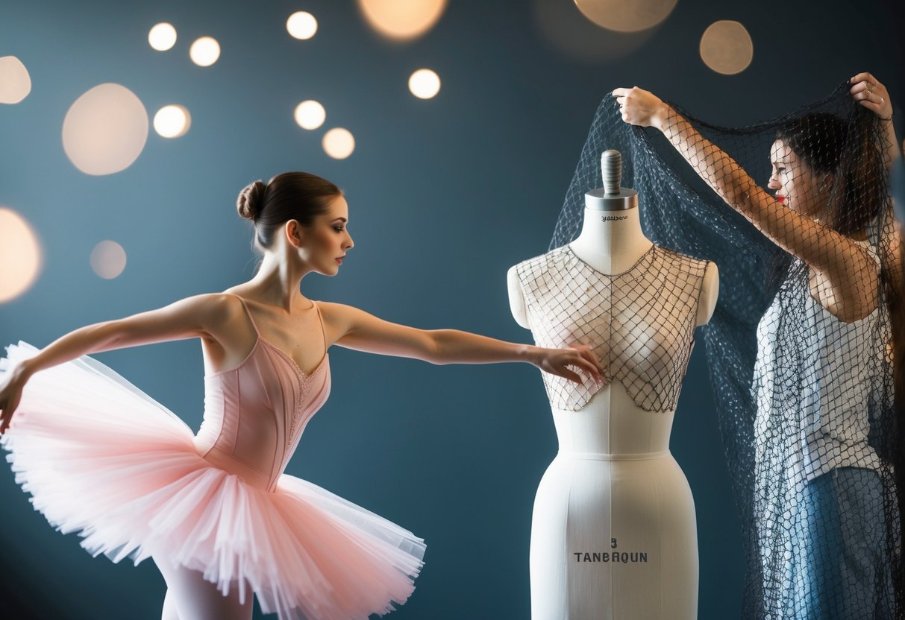
Tulle and mesh fabrics serve distinct purposes in fashion and decorative applications, with each material offering unique properties that make them suited for specific uses.
Bridal Wear
Tulle fabric is ideal for veils and wedding dress details due to its delicate, ethereal appearance. Wedding dresses often feature tulle overlays to create volume and drama.
Brides choose tulle for cathedral-length veils because it creates a soft, floating effect as they walk down the aisle. The fabric’s lightweight nature allows for multiple layers without adding bulk.
Many wedding gowns incorporate tulle underskirts to achieve the perfect amount of fullness. The material’s ability to hold its shape makes it excellent for creating structured petticoats.
Evening Gowns
Fine mesh and tulle fabrics appear frequently in formal wear, particularly in haute couture designs. Designers layer these materials to create depth and dimension in evening gowns.
Mesh panels often feature in strategic locations to create illusion necklines and sleeves. The material’s strength makes it perfect for form-fitting sections of dresses.
Tulle ruffles and gathered sections add romantic touches to formal gowns without weighing down the garment.
Costumes
Ballet tutus rely on stiff tulle to maintain their iconic shape. The fabric’s rigidity allows dancers’ movements to be seen clearly while providing necessary coverage.
Theatrical costumes use both materials extensively. Mesh serves as a base for attaching sequins and beading, while tulle creates ethereal effects for fairy costumes and period pieces.
Dance costumes benefit from mesh’s durability and stretch properties, making it ideal for bodices and sleeves that must withstand frequent movement.
Decor
Event planners use tulle to craft elegant draping for wedding venues and special occasions. The fabric creates soft, billowing effects when properly gathered and hung.
Mesh serves practical purposes in floral arrangements, providing structure and support for elaborate displays. Its strength helps hold heavy blooms in place.
Decorative arches and backdrop installations often combine both materials. Tulle adds softness while mesh provides the necessary framework to maintain shapes.
Comparative Analysis
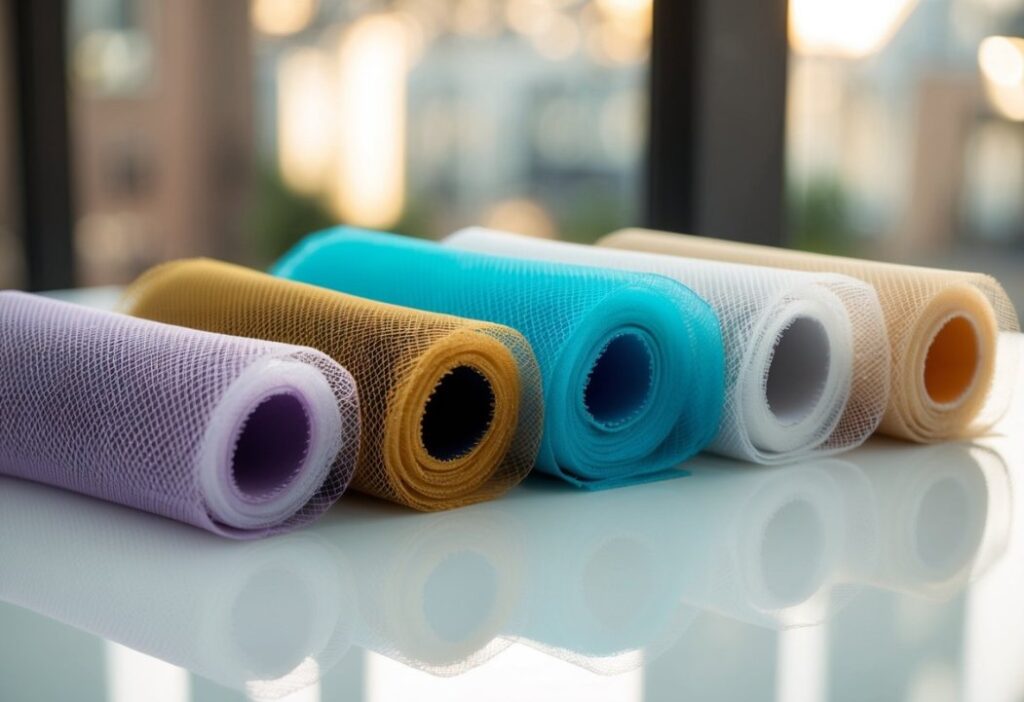
Mesh and tulle serve distinct roles in fashion and design, with each fabric’s unique properties making them suited for specific applications. Their structural differences create varying effects in garments and decorative pieces.
Tulle Versus Mesh in Fashion
Tulle brings elegant qualities to formal wear and special occasion garments. Its fine, delicate appearance makes it perfect for wedding veils, ballet tutus and evening wear.
Mesh fabric offers more durability and structure. Its sturdy construction makes it ideal for sportswear and modern fashion pieces that require breathability.
Bridal illusion, a specific type of tulle, creates a soft, romantic look for veils. Stretch illusion provides more flexibility, whilst glimmer illusion adds subtle sparkle to formal attire.
Application in Design
Mesh serves functional purposes in clothing design, offering:
- Enhanced ventilation
- Strength and durability
- Modern, sporty aesthetics
- Layering capabilities
Tulle excels in decorative applications:
- Dress overlays
- Formal wear details
- Event decorations
- Ballet costumes
Choice of Material
The selection between mesh and tulle depends on specific project requirements. For breathable activewear, mesh is the superior choice.
Tulle works best for delicate overlays and formal garments where aesthetics take priority. Its lightweight nature pairs beautifully with chiffon in layered designs.
When combining fabrics, designers often use mesh for structural support and tulle for decorative elements. This combination creates depth and visual interest in complex garments.
Sewing with Tulle
Working with tulle fabric requires special care and attention due to its delicate nature. A few key techniques will help create beautiful results.
Use a fine needle size 60/8 or 70/10 when sewing tulle. This prevents large holes and damage to the fabric. Always test your stitches on a scrap piece first.
Sharp scissors are essential for cutting tulle cleanly. Regular fabric scissors can snag and tear the material. Cut slowly and carefully to maintain neat edges.
For wedding gowns and dance costumes, use French seams to create clean, professional finishes. This technique encloses raw edges completely and prevents scratchy seams against the skin.
Never pin through the middle of tulle. Place pins only along seam allowances to avoid visible holes in the finished garment. Consider using pattern weights instead of pins when cutting.
Gathering tulle for petticoats requires a longer stitch length and gentle handling. Pull gathering threads slowly to prevent snapping. Multiple layers create the classic full shape.
A walking foot attachment helps feed layers evenly through the machine. This is especially helpful when sewing multiple tulle layers together.
Use tissue paper underneath tulle when sewing to prevent it getting caught in the feed dogs. The paper tears away easily after stitching.
Frequently Asked Questions
Mesh and tulle serve distinct purposes in fashion and textiles, from athletic wear to bridal gowns. Their unique properties and manufacturing methods create specific advantages for different applications.
What distinguishes tulle from mesh in terms of fabric characteristics?
Tulle features a fine, netted structure with hexagonal holes, creating a delicate and airy appearance.
Mesh has a more structured weave with varying hole sizes and shapes, offering greater durability and strength. The fabric’s construction allows for better airflow and flexibility.
In comparison between tulle, mesh, and chiffon, what are the primary differences?
Chiffon offers a lightweight, flowing texture with a slight sheen and transparent quality.
Mesh provides sturdy construction with visible holes for ventilation. Tulle maintains a stiffer structure with a consistent pattern of small holes.
What are some common uses for tulle fabric in textile design?
Tulle excels in formal wear, particularly wedding gowns and ballet tutus. Its ethereal quality makes it perfect for veils and decorative overlays.
The fabric also serves well in home décor, often used for curtains and event decorations.
Can you identify alternative terms that are synonymous with mesh fabric?
Mesh fabric is sometimes called net fabric or netting. Power mesh and stretch mesh refer to specific varieties with elastic properties.
What drawbacks should one be aware of when utilising tulle in garment construction?
Tulle can snag easily and requires gentle handling during construction. The fabric may irritate sensitive skin due to its stiff texture.
Multiple layers are often needed for opacity, which can increase production costs.
What kind of fibres are typically used to produce mesh fabrics?
Mesh commonly utilises synthetic fibres like polyester and nylon for durability and moisture-wicking properties.
Modern athletic mesh often incorporates spandex for stretch and recovery. Some speciality meshes use natural fibres or metal strands for specific applications.

